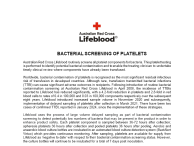Don’t have an account?
Select the donation type you’d like to make
We sample each platelet component at least 36 hours after collection.
Samples are then screened on the bioMerieux BacT/ALERT Automated Microbial Detection System, which uses both aerobic and anaerobic culture bottles.
After sampling, platelets are released to inventory as “culture negative to date” but continue to incubate the culture bottles for 7 days from inoculation.
What if there’s a positive result?
If a culture becomes positive, the screening equipment automatically flags this as ‘initial machine positive’ (IMP).
An IMP is not conclusive evidence that the component is contaminated as the majority of IMP flags are actually false positives.
As a sample could potentially flag as a positive at any time, we’ve set up remote monitoring of the testing system 24 hours a day, 7 days a week (24/7). We also have 24/7 recall with a National Recall Office.
If the platelets and/or their associated components (e.g. red cell or plasma) have already been issued at the time of the IMP, our National Recall Office notifies the relevant Transfusion Service Provider so that they can recall the platelet and any associated components.
If the component has been transfused, the Transfusion Service Provider will contact the treating clinician for them to manage the patient with the knowledge of the preliminary result.
We send all positive culture bottles to an external reference laboratory to have a Gram stain, organism ID and antibiotic sensitivity (if not a common skin contaminant). All organisms identified from the Gram stain are notified to the relevant transfusion laboratory.
Gram stain results are generally available several hours after the IMP is obtained.
Negative Gram stain results are not notified as they are a poor predictor of the absence of contamination and are unlikely to change the management of the patient.
As relevant additional information becomes available, a progress report is sent to the Transfusion Service Provider, such as donor information that might assist in the management of the transfused patient or further information, including bacterial identification and antibiotic sensitivity.
In all cases where components have been transfused, a final report is forwarded to the Transfusion Service Provider when all laboratory investigations are complete.
Every attempt is made to provide the identification of cultured bacteria, and where possible, antibiotic sensitivity testing is also performed.


